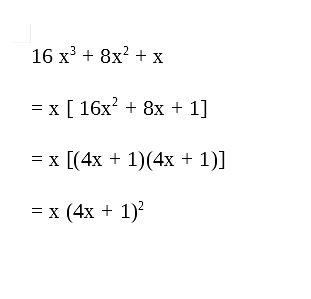LIM TENG SHUEN ERNEST's answer to Cindy's Secondary 1 Maths Singapore question.
Could you explain how you transited the 1st step to the 2nd step? Is there a rule for factorising or how do we find out that two expressions can be squared?
The quadratic expression has a maximum power of x of 2. This means you should look for two terms with x with power 1 to multiply together.
(ax + b)(cx + d)
The final term of the expression is 1. The only integers you can multiply to get +1 is +1/+1 or -1/-1. Since there are no negative terms in the expression, +1/+1 is the answer
(ax + 1) (cx + 1)
While there are a few pairs of factors for 16, 16/1, 8/2, 4/4, only substituting 4/4 gives you the 8x term when you expand it out.
Thus the answer is
(4x + 1)(4x +1)
There is a always a bit of guess and check involved with factorising, but it shouldn't take too long to work out which case is correct.
(ax + b)(cx + d)
The final term of the expression is 1. The only integers you can multiply to get +1 is +1/+1 or -1/-1. Since there are no negative terms in the expression, +1/+1 is the answer
(ax + 1) (cx + 1)
While there are a few pairs of factors for 16, 16/1, 8/2, 4/4, only substituting 4/4 gives you the 8x term when you expand it out.
Thus the answer is
(4x + 1)(4x +1)
There is a always a bit of guess and check involved with factorising, but it shouldn't take too long to work out which case is correct.



